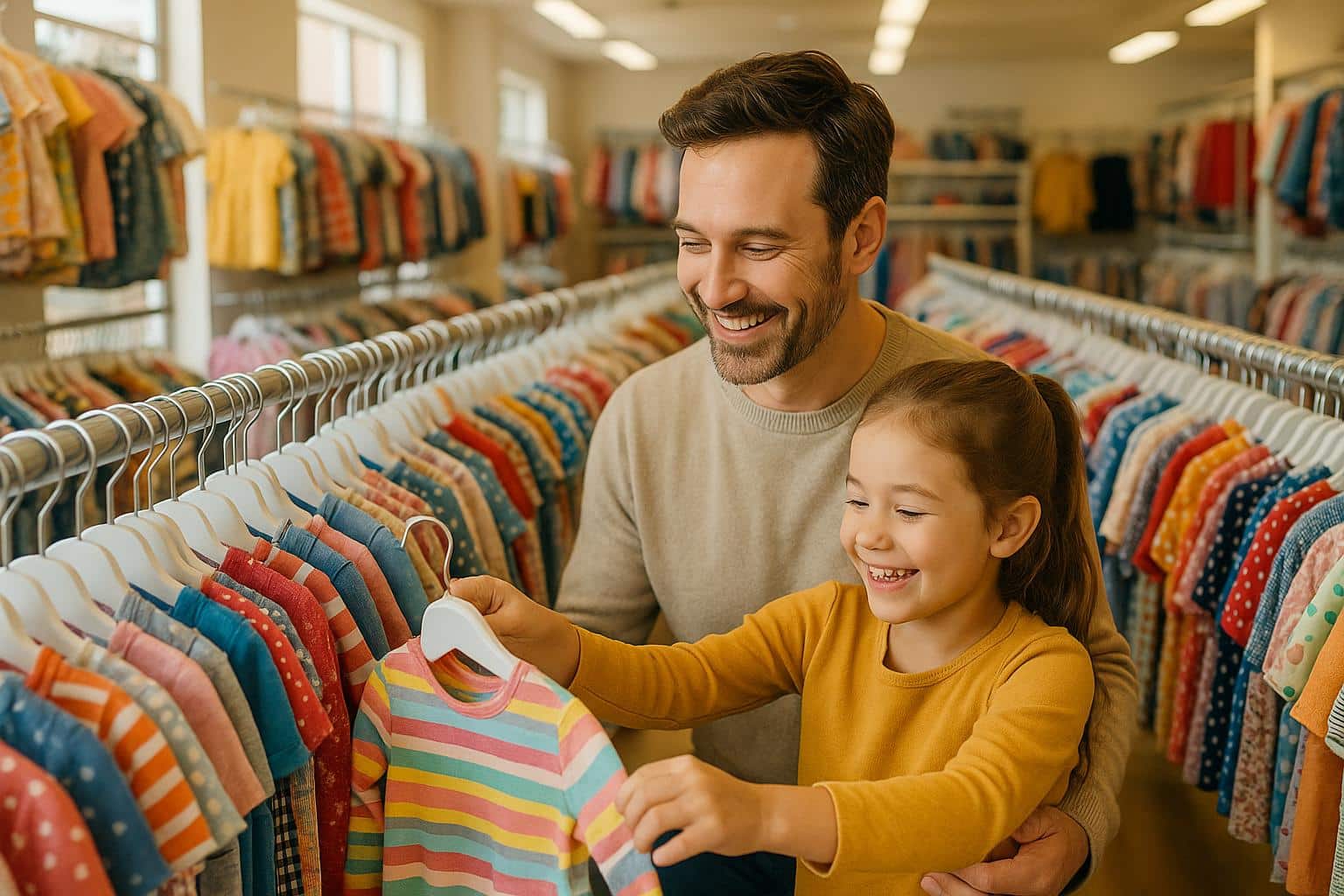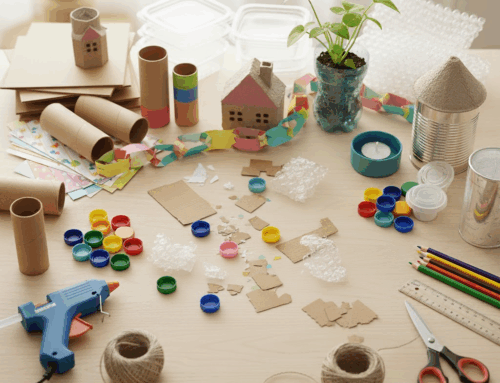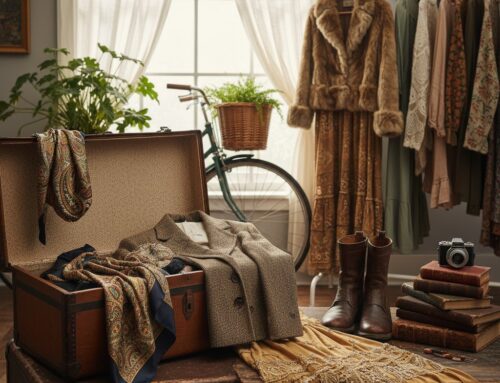Keeping up with kids’ clothing needs doesn’t have to be expensive or wasteful. Thrifting offers a budget-friendly way to shop while giving clothes a second life. Here’s a quick breakdown of how to make the most of your thrifting trips:
- Know your child’s measurements: Skip unreliable age-based sizes by using exact chest, waist, height, and inseam measurements.
- Make a shopping list: Prioritize essentials like seasonal clothes or school uniforms to avoid unnecessary purchases.
- Shop regularly and off-season: Visit thrift stores often and buy winter clothes in summer or vice versa for better deals.
- Inspect for quality: Check seams, fabric, closures, and avoid items with hard-to-remove stains or odors.
- Pick versatile items: Look for layerable pieces like base layers, mid-layers, and weatherproof outerwear.
- Set a budget: Plan your spending and use tools like budgeting apps to stay on track.
- Choose the right store: Non-profit thrift stores often support community causes, while consignment shops focus on curated, higher-quality items.
- Involve your kids: Teach them budgeting and quality-check skills while making the trip fun.
- Donate outgrown clothes: Keep the cycle going by giving back to your community.
- Look for sales: Take advantage of special deals, sales days, and store newsletters for extra savings.
Thrifting isn’t just about saving money – it’s also a way to reduce waste and support local initiatives. Whether you’re buying or donating, every step contributes to a more mindful approach to shopping.
1. Know Your Child’s Current Sizes and Measurements
Before diving into the thrift store hunt, take a few minutes with a measuring tape to get your child’s current measurements. Age-based sizing isn’t reliable – what fits one child at a certain age may not work for another. Having these exact numbers makes shopping much easier and avoids unnecessary returns.
Start with the chest by wrapping the tape around the fullest part of your child’s chest. Keep it level and snug, but not tight. For the waist, measure around the narrowest part of their torso, usually just above the belly button. If you’re shopping for pants, the inseam is key – measure from the crotch to where you want the hem to hit.
Also, keep track of their height and weight. These can help you figure out size ranges, especially when brands vary in how they fit. One brand’s size 8 might feel more like a size 6, or pants that fit the waist might have an awkwardly short rise. Accurate measurements can save you from these frustrating surprises.
Measure regularly. If your child is growing quickly, update measurements every three months. For slower growers, twice a year should do the trick. Growth spurts can sneak up on you, and outdated numbers might leave you with clothes that don’t fit and end up collecting dust in the closet.
2. Make a Shopping List for Needs and Priorities
Walking into a thrift store without a game plan can easily lead to impulse buys and overlooked essentials. Start by taking stock of your child’s wardrobe. Check what still fits, what’s worn out, and what’s missing. This simple step keeps you focused and helps avoid buying duplicates or unnecessary items.
Take a systematic approach: go through shirts, pants, and must-haves like undergarments. Think ahead to upcoming seasons and events. For example, in August, prioritize fall and winter clothing and make note of specific needs – like outfits for school picture day.
Get your kids involved by asking for their wishlist items. This ensures your finds are both practical and something they’ll actually be excited to wear.
When shopping, aim to build a wardrobe that works together seamlessly. A “capsule wardrobe” is a great idea – look for versatile pieces that mix and match easily. A solid-colored sweater, for instance, can pair with several bottoms, and neutral pants can complement a variety of tops. This strategy not only makes outfit planning easier but also helps you get more bang for your buck.
Write down your list and prioritize essentials like winter coats or school uniforms over less critical items. A well-thought-out list ensures your thrift store trip is efficient and productive.
3. Visit Regularly and Shop Off-Season
Thrift stores are like treasure chests that get restocked daily with new donations. This fast-paced turnover means timing your visits can make all the difference. Every time you stop by, there’s a chance to uncover something new and useful.
“Visit early for the best selection – and come back often, as our inventory changes weekly.” – Life Network Family Thrift Stores
Consistency is key when it comes to thrift shopping. Babies grow out of their clothes every 2–3 months, and toddlers need new sizes about every 6 months. With growth spurts happening so quickly, regular visits can help you stay ahead of your kids’ wardrobe needs without breaking the bank.
Shopping off-season is another way to maximize your savings. Instead of joining the rush for winter coats in the fall, consider picking them up in the summer when prices are often lower. Thrift stores tend to see a surge in seasonal items as kids outgrow their clothes, making it the perfect time to snag great deals.
Think ahead: shop for fall and winter clothes in August, and stock up on spring and summer outfits in January. Many of these items are gently used and donated just as kids outgrow them, so you’re likely to find quality options.
Make thrift store visits a regular part of your routine. Whether it’s a quick stop during errands or a dedicated monthly trip, consistency can help you discover the best deals and learn when new items hit the shelves. Stores like City Thrift, with their rotating donations, ensure there’s always something fresh to find for your kids.
4. Inspect for Quality and Durability
Before you commit to buying a thrifted garment, take a moment to give it a thorough inspection. This step is key to making sure your find will last and serve you well.
Start by turning the garment inside out and examining how it’s put together. Pay close attention to the seams and stitching, especially in high-stress areas like the shoulders, crotch, and underarms. Well-constructed pieces are less likely to fall apart after a few wears.
Next, check the fabric itself. Natural fibers like organic cotton, hemp, and linen tend to be sturdier and hold their shape and color better over time compared to synthetics like polyester, nylon, or acrylic. If durability is important to you, natural fabrics are usually a safer bet.
Look for any stains or discoloration under strong lighting. While small blemishes might be fine for casual or play clothes, steer clear of items with extensive staining that could be difficult to clean.
Don’t forget to test the closures. Make sure zippers glide smoothly and that buttons or snaps are firmly attached. You don’t want to discover a broken zipper or missing button after you’ve brought the item home.
Lastly, give the garment a sniff test. If it smells musty, overly perfumed, or has a strong chemical odor, it might not be worth the trouble. While washing secondhand clothes with unscented detergent can help remove odors and chemical residues, some smells are harder to eliminate. A quick wash before wearing ensures your new find is fresh and ready to wear.
5. Look for Multi-Purpose and Layerable Pieces
Once you’ve ensured the quality and durability of your thrift finds, the next step is to focus on versatility. Opt for items that can adapt to different seasons and occasions. This not only stretches your budget but also keeps your child’s wardrobe more organized. A smart way to achieve this is by thinking in layers – base, mid, and outer – so you can mix and match as the weather or activity demands.
“Children grow rapidly, often outgrowing clothes before they have a chance to wear them out. By purchasing gently-used clothing from thrift stores, parents can save a substantial amount of money.”– Thrift World
Base layers are the building blocks of any outfit and should be your top priority when thrifting. Look for long-sleeve shirts, T-shirts, and leggings made from moisture-wicking fabrics like merino wool or polyester blends. These materials help keep kids dry and comfortable, even during active play. For example, a merino wool long-sleeve shirt can double as a light pullover in spring or a cozy layer under sweaters in winter. Avoid cotton for active kids – it dries slowly and loses warmth when wet.
Mid-layer pieces, such as fleece jackets, hoodies, or lightweight sweaters, are great options because they provide warmth without being too bulky. These layers are easy to adjust throughout the day, making them ideal for fluctuating temperatures.
For outer layers, focus on windproof and waterproof options made from breathable materials like nylon. Lightweight rain jackets and windbreakers are fantastic thrift store finds – they protect against unexpected weather while still allowing airflow. Steer clear of non-breathable materials like rubber raincoats, which can trap sweat and make kids uncomfortable.
Don’t forget accessories to round out your thrifted wardrobe. Scarves, hats, and gloves are small but mighty additions that enhance the functionality of your child’s clothing. For summer, look for caps with UV protection, and for winter, choose hats that cover the ears. When it comes to footwear, prioritize waterproof and breathable options for wet conditions, and grab easy slip-on styles for everyday convenience.
Fit and functionality are key when selecting layerable pieces. Base layers should fit snugly but allow for movement, while mid and outer layers can have a little extra room for growth. Adjustable features like extendable sleeves or cuffs are a bonus – they make layering easier and allow the clothes to last longer.
6. Set a Budget and Stick to It
Once you’ve found those great thrift store gems, sticking to a budget ensures you make the most of your purchases without breaking the bank. Treat thrift shopping like any other planned expense. Before you even set foot in a store, decide on a firm spending limit. This simple step can help you avoid overspending or succumbing to impulse buys that can quickly add up. Without a clear budget, it’s easy to get swept up in the excitement of bargains and spend far more than planned.
A practical way to approach this is by setting a monthly budget specifically for kids’ clothing. By aligning your spending with a pre-made list, you can avoid unnecessary purchases that could throw off your financial goals.
To help you stay on track, consider using digital tools. Budgeting apps like Mint or You Need a Budget (YNAB) can be incredibly useful for keeping tabs on your spending in real time. These apps can even send you alerts when you’re nearing your limit, making it easier to stick to your plan.
Another tip? Sign up for thrift store newsletters. Many stores, such as City Thrift in Kansas City, offer early access to sales and exclusive promotions for email subscribers. If you’re shopping online, tools like Honey or Rakuten can automatically apply discount codes at checkout. You can also set up Google Alerts to stay informed about deals at local thrift stores. By taking these steps, you’ll not only save money but also support community-driven initiatives in a thoughtful and organized way.
7. Choose the Right Store
Picking the right thrift store isn’t just about finding great deals – it’s also a chance to make a positive impact. Different types of thrift stores offer unique benefits, so knowing what to look for can help you make choices that support both your family and your community.
Non-profit thrift stores are often a top choice for shoppers who want quality items while contributing to a good cause. For example, stores like City Thrift maintain high donation standards to ensure quality inventory. But they do more than just sell secondhand items – they operate with a mission. At City Thrift, all proceeds directly support City Union Mission, which funds programs aimed at tackling homelessness and poverty in the Kansas City area.
On the other hand, for-profit chains tend to prioritize quick inventory turnover, which can sometimes mean lower-quality items. Meanwhile, community-focused stores often take a more thoughtful approach to managing donations, which can lead to better finds. Keep in mind that the location of a thrift store can also influence the quality of its inventory.
Shopping at stores with a community-driven mission, like City Thrift, means your purchases go beyond just snagging a great deal. Every dollar spent helps provide meals, shelter, and other essential services through City Union Mission. It’s a simple way to turn your shopping trip into an act of support for local initiatives.
Some thrift stores also offer volunteer opportunities, which can be a great way to get involved. Volunteering not only allows you to give back but also gives you a behind-the-scenes look at how donations are processed and what items make it to the sales floor. This insight can sharpen your thrift-shopping skills and deepen your connection to the store’s mission.
Choosing the right store can make your thrifting experience smoother and more rewarding, all while reinforcing the values of community and generosity.
8. Involve Kids in the Process
Why not make thrift shopping a family affair? Bringing your kids along can turn what might feel like a chore into an opportunity for learning and bonding. Plus, it’s a great way to teach them important life lessons while introducing them to the benefits of secondhand shopping.
Start with a simple budgeting lesson before heading out. Give each child a small amount – say $10 or $15 – and let them use it to shop for their own clothes. This hands-on experience teaches them how to manage money, weigh their options, and make thoughtful choices between what they truly need and what they simply want.
Make the experience fun by turning it into a treasure hunt. For younger kids, create challenges like finding items in a specific color. Older kids can hunt for particular pieces that fit within their budget. This keeps them engaged and turns the trip into a game rather than a boring errand.
Use the opportunity to teach them how to check for quality. Show them how to look for stains, tears, or worn-out areas and test zippers. Kids are naturally curious, and explaining why these checks matter makes them feel involved. They might even surprise you by spotting things you’d overlook!
Encourage them to try on clothes to learn about fit and comfort. The fitting room experience is valuable – it helps kids understand how clothing should look and feel, and it avoids the frustration of buying something that doesn’t work once you’re home.
Celebrate their finds to keep them excited about thrift shopping. If they discover a great piece or snag a fantastic deal, acknowledge it! This gives them a sense of accomplishment and makes them look forward to the next trip.
Finally, take a moment to explain how their purchases help others. Let them know that buying from thrift stores often supports community programs. This not only makes them feel good about their choices but also helps them develop a sense of social responsibility early on.
9. Donate Outgrown Clothes and Support the Community
Thrifting is just one part of the equation – donating outgrown clothes completes the cycle, helping not only your family but also the local community. By passing along items your kids have outgrown, you’re giving those clothes a second life while making a meaningful difference.
Kids grow quickly, and it’s easy for closets to fill up with clothes that no longer fit. Instead of letting those items gather dust or end up in a landfill, donate them. That beloved dinosaur t-shirt or lightly worn winter coat could become a cherished find for another family.
The impact of your donation goes far beyond just clothing. For example, donations to City Thrift directly support City Union Mission’s programs, which provide meals, shelter, and vital resources to local families in need. Every item you give contributes to this important mission.
Make donating a family activity. Involve your children in the process to teach them about the importance of generosity and how sharing can positively impact others. It’s a simple way to instill values that will stick with them for a lifetime.
To make the biggest impact, consider the timing of your donations. Drop off winter clothes in early fall and summer items in late spring – this ensures families can access what they need when they need it most.
Before donating, take a moment to clean and repair the items. A quick wash or replacing a missing button can make a big difference, helping the clothes find new homes faster and in better condition.
Donating not only keeps clothing in use for longer but also reduces textile waste and supports sustainable practices. By ensuring your items are clean and ready to wear, you maximize their value and usefulness.
Lastly, don’t forget to keep your donation receipts for tax purposes. It’s a small step that can benefit you while you’re helping others.
10. Check for Special Deals and Sale Days
Timing your thrift store visits can make a big difference in how far your budget stretches. Many stores offer special deals, discounts, or sale days, and knowing when these happen can help you save even more.
Start by asking the store staff about their discount schedules or looking for posted promotions. Seasonal clearance events are also a great opportunity to snag items at lower prices as stores make room for new inventory. Holidays like Memorial Day and Labor Day are particularly good times to shop, as many stores offer extra discounts during these periods.
To stay in the loop, consider signing up for store newsletters or following their social media accounts. These channels often announce flash sales and limited-time promotions. For example, at City Thrift, keeping an eye on their promotional calendar can help you save while also supporting community programs through City Union Mission. Shopping in the mornings on weekdays can even give you a chance to get personalized assistance on current deals.
With a little planning, you can maximize your savings and contribute to a good cause at the same time.
Comparison Table
Understanding the different types of thrift stores can help you make smarter choices when shopping for kids’ clothes. Each type offers distinct perks and serves unique purposes, so knowing what to expect can save both time and money.
| Store Type | Quality & Selection | Community Impact | Best For |
|---|---|---|---|
| Non-Profit Thrift Stores (e.g., City Thrift) | Wide variety of community-donated items, often with unique finds | High – Purchases support local programs like homelessness and poverty relief | Families looking for affordable options while contributing to their community |
| Consignment Shops | Carefully selected, often featuring popular name brands | Low Profits benefit store owners and consigners | Parents seeking name-brand items or special occasion outfits |
| Large Chain Thrift Stores | Large, consistent inventory with organized displays | Medium – Primarily profit-driven but may support some local initiatives | Shoppers who want a wide selection and an easy-to-navigate layout |
Each type of store has its strengths. Non-profit thrift stores, like City Thrift, are perfect for budget-conscious families who also want their purchases to support meaningful community initiatives. These stores often feel like a treasure hunt, with unique and unexpected finds.
Consignment shops, on the other hand, focus on quality over quantity. They’re a great choice if you’re looking for specific brands or standout pieces, especially for special occasions. While their impact on the community is smaller, their curated inventory appeals to shoppers who value quality.
Large chain thrift stores offer a broader range of items and a more predictable shopping experience. If you prefer a store with a consistent layout and plenty of options to choose from, these are a reliable choice. While their community impact might not be as strong as non-profits, they still provide affordable options for a variety of needs.
Ultimately, the best choice depends on what matters most to you – whether it’s supporting a cause, finding high-quality items, or having access to a large selection in one place.
Conclusion
Thrifting kids’ clothes is a smart way to save money while keeping your little ones dressed in style. With the average family spending about $700 per child each year on clothing, secondhand shopping can slash those costs by 60–90% off retail prices. Plus, it’s a great opportunity to teach kids about budgeting, reusing items, and making more thoughtful choices when it comes to consumption.
But the benefits go beyond just saving money. Thrifting plays a key role in reducing textile waste and supporting the circular fashion movement. This is especially important for kids’ clothing, which is often outgrown quickly. By giving these items a second life, families contribute to a more sustainable future. And with the U.S. secondhand apparel market expected to hit $70 billion by 2027, it’s clear this way of shopping is gaining momentum.
Shopping at local non-profit thrift stores, like City Thrift, adds another layer of impact. Every purchase helps fund vital community programs, meaning your thrift finds not only save you money but also support your neighbors. It’s a win-win for your wallet and your community.
Donating outgrown clothes keeps the cycle going strong, helping others and reducing waste. Many thrift stores even offer volunteer opportunities, making it easy for families to connect and give back to their local communities.
FAQs
How can I make sure thrifted kids’ clothes are safe and gentle on their skin?
When buying thrifted clothes for kids, it’s important to make sure they’re clean and gentle on sensitive skin. Start by washing the clothes in hot water with a mild, hypoallergenic detergent. This will help get rid of any dirt, allergens, or leftover chemicals. For extra peace of mind, you can run them through a second rinse cycle to remove any detergent residue.
When choosing items, look for fabrics like organic cotton or bamboo. These materials are naturally soft and less likely to irritate delicate skin. Steer clear of clothes with strong odors or visible stains, as they might be tough to clean completely. Also, take a moment to check the fabric for durability and comfort to ensure the clothes will hold up and feel good for your little ones.
How can I make thrifting with my kids enjoyable and educational?
Thrifting with your kids can be both enjoyable and educational! Begin by including them in creating a budget and selecting items, which introduces them to basic money management and smart decision-making. Make it even more exciting by turning it into a game – challenge them to spot the best bargains or discover unique treasures. Let their creativity shine by encouraging them to pick out items they’d like to personalize or transform through upcycling projects at home. These activities not only make the experience more fun but also teach practical life skills and nurture an appreciation for secondhand shopping.
What are the benefits of donating your child’s outgrown clothes to thrift stores like City Thrift?
Donating your child’s outgrown clothes to thrift stores like City Thrift benefits both the community and the planet. For families, it means access to affordable clothing options. Plus, it supports charitable initiatives such as City Union Mission, which helps individuals experiencing homelessness and poverty.
On the environmental side, donating prevents clothes from ending up in landfills, cuts down on textile waste, and saves resources that would otherwise go into making new clothing. This simple gesture plays a part in protecting the planet and creating a better future for the next generation.





